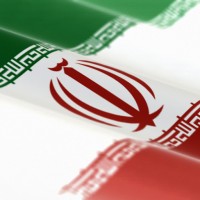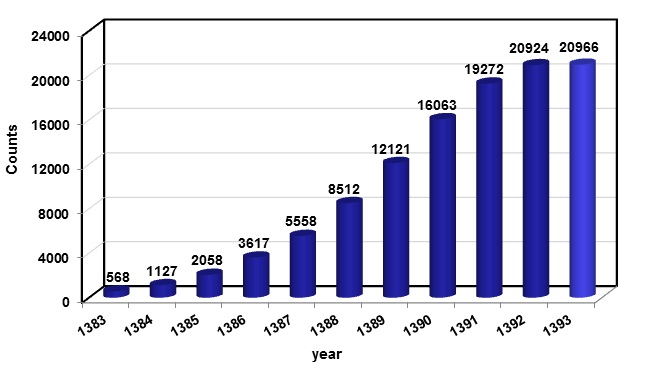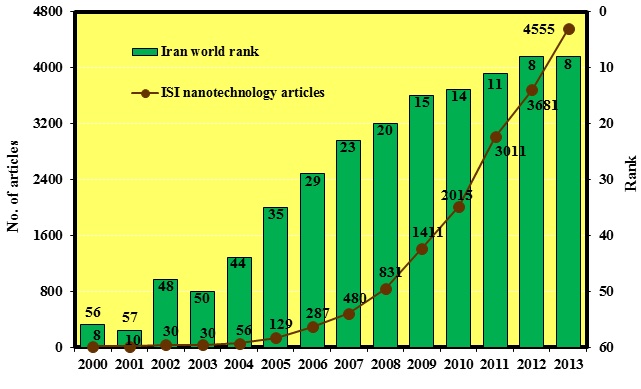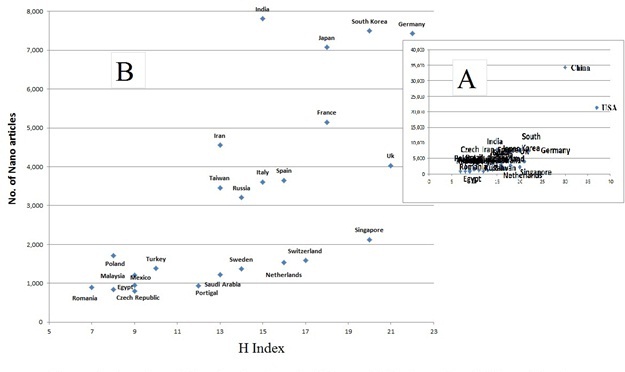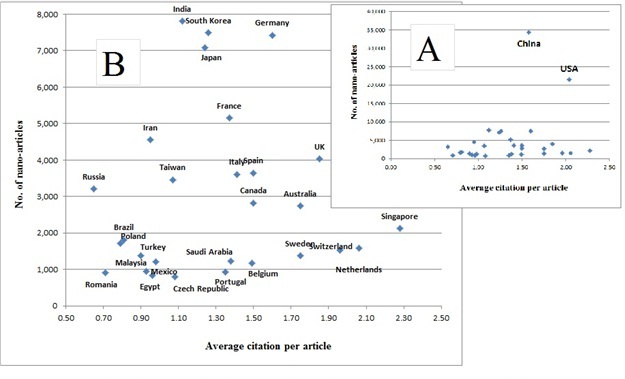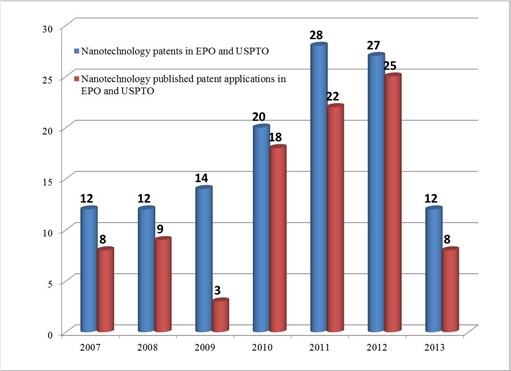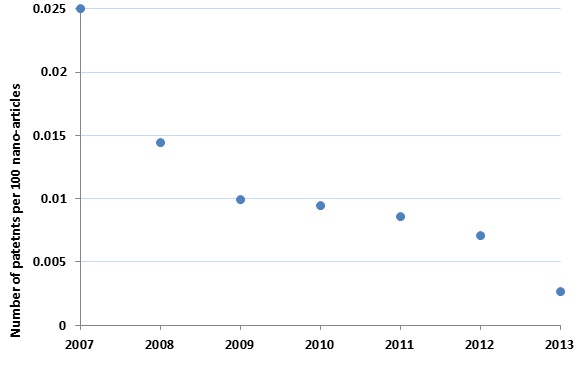Iran is a country located in the Southwest of Asia in the Middle-East with an area of 1,648,195 sq km. According to The World Bank, in 2012 Iran has a population of 76,424,400. Tehran is the capital, the largest city, and the political and administrative capital of Iran. Iran is important strategically due to its location in Eurasia zone. The country is a member of the United Nations (UN), Non-Aligned Movement (NAM), Organization of the Islamic Cooperation (OIC), Organization of the Petroleum Exporting Countries (OPEC), Economic Cooperation Organization (ECO), and a number of other international organizations. Iran is considered a local force in the Southwest of Asia, and it has acquired important position in the global economy due to possessing petroleum and petrochemical industries, natural gas, and auto industry [1].
Beginning of Nanotechnology in Iran
First sparkles of nanotechnology in Iran were lit in 2001, and nanotechnology strategic studies began by the command of the former Iranian president. Two years after the beginning of the studies, Iran Nanotechnology Initiative Council was established in 2003[2]. The Council prepared a nanotechnology strategic plan for the next two years, and it handed the plan over to the cabinet. The plan was approved in 2005 by the cabinet. Policies and strategic plans for the improvement and development of nanotechnology were approved in 2006. Iran Nanotechnology Initiative Council created various workgroups for the development of nanotechnology, among which mention can be made of Industry and Market Workgroup, Tech-Market Services Corridor, Nanotechnology Development Workgroup, Human Resources Development Workgroup, Technology Infrastructures Workgroup, Promotion and Culture-making Workgroup, International Affairs Workgroup, and Policy-making and Evaluation Workgroup.
Nanotechnology Strategic Plan
It is a ten-year plan [3] that started in 2005 and ends in 2014. Programs in the plan are classified in the three sections of short term (2005-2007), mid-term (2008-2010), and long term (2011-2014) programs. Nanotechnology strategic plan for the next 10 years is being devised at the moment, and it includes the period between 2015 to 2025.
The main goal of the first ten-year strategic plan is the production of wealth and improving life quality of the people. One of the major missions in the plan is that Iran must be among the top 15 countries by 2014. To this end, various strategic programs have been considered in the plan to develop human resources, production of science, development and innovation development, and finally the production and commercialization of products and the presentation of the products to the international markets.
National Priorities
Energy, health, water and environment, construction, and nanomaterials industry are Iran’s national priorities in the field of nanotechnology. Taking into consideration the fact that petroleum and gas are among the main industries in Iran, energy zone is the main priority in the field of nanotechnology research. Fuel cells and petrochemical industries are among national priorities in the field of energy.
Public Promotion of Nanotechnology
Public promotion of nanotechnology is one of the unique characteristics of nanotechnology development program in Iran in comparison with other countries. Significant attention to public education of nanotechnology, especially at school level, is clearly observed in Iran. Iran Nanotechnology Initiative Council established Nano Club to improve the familiarity of school students with nanotechnology and nanosciences, and to create an environment for the students to carry out research in this field. The innovative organization of Nano Olympiad is one of the promotional programs in Iran. Nano Club’s website started its educational activities on the Internet in 2004, and it has programmed and carried out various educational activities since 2008. The Club tends to guide students through an educational process from learning basic concepts to creating knowledge-based ideas, so that their academic research will be based on what they have learned and experienced in Nano Club after their graduation. Provision of the opportunity for teamwork is one of the most important principles in Nano Club. The interdisciplinary nature of nanoscience and nanotechnology is a concept that is practically taught to students during their activities in the Club. Nano Bell Monthly, Nanotechnology Monthly, and Nano Club website are among other activities of Iran Nanotechnology Initiative Council in line with the promotion of nanotechnology. Among other programs carried out in students’ section, mention can be made of the establishment of seven laboratories for students in research houses[4].
A special exhibition is annually held in Tehran entitled Iran Nanotechnology Festival in a bid to introduce nanotechnology achievements to the public. In the festival, Iranian products and achievements are presented to the visitors. Iran Nanotechnology Initiative Council has some programs to promote nanotechnology in industries, among which mention can be made of drawing the tree for nanotechnology applications in various industries, producing and releasing short industrial reports with focus on products and current technologies in a specific industry, publishing nanotechnology monthly industrial magazines, producing and distributing nanotechnology and industry software, and documenting successful experiences in science production cycle, technology production, producing products, and production of wealth.
Human Resources Development
Taking into consideration the importance of training nanotechnology experts, PhD courses have been organized in 15 universities in Iran in the past 10 years. Students study at those universities in nanochemistry, nanophysics, nanomaterials, nanomedicine, and some other related majors. A number of 34 universities organize nanotechnology courses at MSc level. 1554 PhD theses have so far been carried out in the field of nanotechnology, and 1040 theses are being carried out at the moment. At MSc level, 9214 theses have been carried out and 3345 are currently being carried out. The number of members of the scientific boards in universities, active in the field of nanotechnology, was 244 in 2004 and it reached 2632 in 2013. In addition, many books have been published in the field of nanotechnology, among which mention can be made of 32 international books and 126 volumes of books in Persian. Figure 1 demonstrates the number of nanotechnology researchers in Iran. In the past 10 years, the number of researchers has increased significantly.
Figure 1: Number of Nanotechnology Researchers in 2003-2013
Nanotechnology Laboratory Network
Nanotechnology Laboratory Network was established to share knowledge and facilities in the field of nanotechnology. A number of 57 research centers have so far joined Nanotechnology Laboratory Network, and they have shared 852 devices through the network. Approximately 100,000 services have been provided for the customers in the network in 2013. Nanotechnology Laboratory Network started to establish expert workgroups in 2009, and six workgroups are currently active in TEM, SEM, X-ray, SPM, standard and calibration, chromatography, and element analysis zones [5].
Nanotechnology Standard Committee
The Committee was established in 2006, aiming to devise and publish standards in the field of nanotechnology. The Committee is an active member of ISO/TC229 International Committee, and it has so far published 15 national and two international standards, and it is currently devising 10 other national and one international standards. The creation of Nanotechnology Standardization Committees in the Ministry of Health and Ministry of Agriculture and the creation of Nanotechnology Safety Network are among the achievements of the Committee. Table 1 lists the countries that propose international standards in the field of nanotechnology and the number of their proposed standards.
Table 1: Countries and the Number of Their Proposed International Standards
| Country | No. of Standards | |
|---|---|---|
| 1 | 9 | |
| 2 | 6 | |
| 3 | 5 | |
| 4 | 3 | |
| 5 | 2 | |
| 6 | 2 | |
| 7 | 2 | |
| 8 | 2 | |
| 9 | 1 |
Nanotechnology Safety Network
Taking into account the observation of hygienic, safety, and environmental issues in nanotechnology, the formation of Nanotechnology Safety Network was suggested in the beginning of 2011 in Nanotechnology Standard Committee of Iran Nanotechnology Initiative Council. The aim of the network was to create an appropriate environment for researchers and related centers in the country to carry out their activities in the framework of the specified programs supervised by the network, focusing on the devising standards, regulations, and instructions on safety and environmental issues in nanotechnology. Therefore, Iran Nanotechnology Safety Network will be able to play an important role in the safe development of nanotechnology products in a mid-term outlook. Among the activities of the network, mention can be made of carrying out initial studies, including the identification of experts and active centers in this field. Nanotechnology Safety Network officially started its activities in summer 2012, and it is currently active in the fields of education, devising standards and regulations, and the creation of required infrastructures in the field of nanotechnology [6].
International Cooperation
Eco Nano Network: Iran Nanotechnology Initiative Council proposed the establishment of the network in 2009, and the objectives of the network were to improve nanotechnology level among Eco member countries (Afghanistan, Azerbaijan, Kazakhstan, Iran, Kyrgyzstan, Pakistan, Tajikistan, Turkey, Turkmenistan and Uzbekistan), to exchange experiences and skills among these countries, develop economic share of Eco in knowledge-based exchanges, create regional and international market for nanotechnology products, and finally improve life standards in these countries [7].
The International Center on Nanotechnology for Water Purification (UNIDO) is located in Tehran, and Iran is responsible for the management of the center. Iran has carried out many joint projects with Germany, Russia, India, Taiwan and South Korea, and it is an active member of the Asia Nano Forum (ANF).
Tech-Market Services Corridor
Challenges in the path to grow and develop scientific findings in universities to present the findings to the market are among the problems in the commercialization of the academic achievements. Statistics show that over 80% of the technologies obtained in research centers are never presented to the market. The process to convert an idea to a product requires various informative, managerial, legal and financial infrastructures. Tech-Market Services Corridor has taken into consideration all these needs, and it has located active units in the field of specialized technology services in an integrated complex. Desirable achievements are obtained sooner in various parts after the establishment of this technology development network, and by administrating correct management on research and technology activities. Tech-Market Services Corridor provides services in the following scopes [8]:
- 1.Metrology (scale measurement)
- 2.Services to transfer technology to industry
- 3.Technology documentation services
- 4.Consulting and studying the feasibility of projects and industrial and service providing plans
- 5.Legal services and intellectual properties
- 6.Supportive services to acquire the necessary certificates and standards
- 7.Investment services and financial support
- 8.Tech-market
- 9.Developing and guiding cooperation among technology companies
- 10. Marketing and domestic and international commerce services
The Corridor has a unit to inspect and evaluate nanomaterials and nano products, which evaluates nanotechnology-based products and grants them with nanoscale certificate. The unit is also in charge of supervising scale registration for the products that have acquired nanoscale certificate.
Industry
In the past 10 years, 143 nanotechnology-based companies have been established in eight different industries. Half of the companies are active in the field of health, drug, and materials. Facilities, construction, and building ranked second in the ranking of companies active in the field of nanotechnology. Figure 2 demonstrates the distribution of the companies.
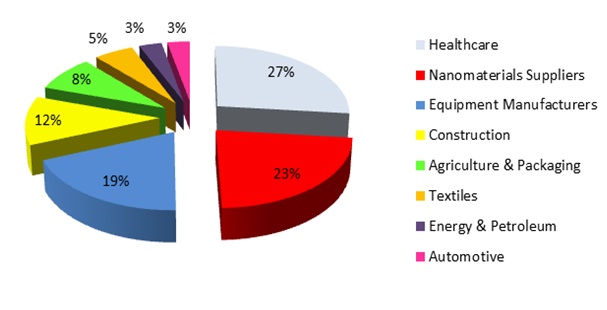
Figure 2: Distribution of Nanotechnology Companies according to their Fields of Activity
The production of laboratorial and industrial devices related to nanotechnology has been one of the major priorities for nanotechnology authorities in Iran. Therefore, numerous stimulus programs have been organized to persuade inventors and researchers to manufacture nanotechnology devices and equipment. Up to 2013, Iranian companies produced 116 devices and presented them to the market. 143 nano-related companies are active in Iran which manufacture 257 nano-products. Some of the companies have been introduced briefly hereafter, and a list of their products has been mentioned.
Fanavaran Nano Meqyas Company: The company is active in the production of electrospinning devices. Among other products of the company, mention can be made of the production of nanofibers semi-industrial production line, electrospinning laboratory system, floating electrospinning laboratory system, melt electrospinning device, co-axial nuzzles, capillary electrophoresis device, high voltage potential difference providers, and syringe-type pump. Exir Nano Sina Company: The company produces and presents sinadoxosome anticancer drug to the market.
Chitotech Company: Chitotech was developed from a research institute that worked on natural biopolymers and their applications in the medical sciences. The productive unit of the company was established in 2005. Chitotech is the first company in the Middle-East that produces antiseptic solutions based on nanosilver, laceration treatment of advanced products, and blood coagulation materials. Laceration Silvosept, burning Silvosept, hand Silvosept, injection antiseptic Silvospet, blood coagulator, and wound treatment materials are among other products of the company.
Parsa Polymer Sharif Company: The company was established in 2007, with over a decade and a half research background, and it started its activities in the field of polymeric advanced compounds. By producing polymeric nanocomposites, the company provides the needs of a wide range of industries, including packaging, transportation, home appliances, and building materials such as pipes, profiles, plates, wires, and cables.
Zist Pazhoohan Khavar Miyaneh Company (Middle-East Bioresearchers): Zist Pazhoohan Company was established in 2004, aiming to reduce the loss in fruits and vegetables in the country, transfer novel technologies and make them applicable in the field of agriculture and industry. Today, the company produces waxes and covers for the fruits, tagging machines, biological research devices, foodstuff quality control devices, and packaging devices.
Science and Technology Indices
The number of published nanotechnology ISI-indexed articles is one of the scientific indices to evaluate the scientific standing of the countries. As is seen in Figure 3, Iran has shown significant growth in this index in the past 10 years, to the extent that it improved its rank to 8th in 2012 while it ranked 56th in 2000. According to the data shown on Stat Nano Website [9], Iran has published 4555 ISI-indexed articles in 2013, and the share of nanotechnology articles from all scientific articles published in Iran was 19%. Among the Islamic countries, Iran shares 3.9% of all nanotechnology articles published in 2013 while Turkey, Saudi Arabia, and Malaysia possess 1.18%, 1.05% and 1.04%, respectively.
Figure 3: Trend of Changes in the Number of Iran’s ISI-indexed Articles and Rank
About 18% of Iran’s nanotechnology articles have been published in association with researchers from other countries in 2011. The percentage reached about 17 (765 articles) in 2012 and 2013. It seems that Iranian researchers have not increased their cooperation with other countries in the past two years. The important point is that Iran has had the least international cooperation with other countries among the top countries in nanoscience production.
Figure 4 shows the trend of changes in h-index value for nanotechnology articles published by the top 30 countries in nanoscience production in 2013. China and the United States ranked first and second highly distanced from other countries. The huge difference can be seen in Chart A in Figure 4. By publishing 21453 and 34379 nanotechnology articles and h-index values of 37 and 30, the United States and China possessed the highest ranks in these two indices, respectively. Chart B has been drawn after the elimination of these two countries so a better arrangement of the countries can be seen on the chart. South Korea, Japan, and Germany had better quantitative and qualitative positions than other countries excluding the United States and China. India and Britain are relatively good in one dimension (quantity and quality, respectively). Iran, Italy, Spain, Canada, and Taiwan are located in the middle of the chart. It can be expressed that there is a balance between the quantity and quality of nanotechnology articles in these countries. Iran is higher than Italy, Spain, UK, Switzerland, Netherlands, and Singapore in the number of nanotechnology articles, but it has a great difference from these countries in the number of highly cited articles.
Figure 4: Number of Nanotechnology Articles and H-Index of Top 30 Countries in Nanoscience Production in 2013
Figure 5 demonstrates the average number of citation per each nanotechnology article besides the number of nanotechnology articles for the top 30 countries in the production of nanoscience in 2013. In this index, too, the United States and China are much higher than other countries. China and the United States published 34379 and 21453 nanotechnology articles in 2013, while the averages of citation per article for these countries have been 1.58 and 2.04, respectively. The chart has been drawn again to show the position of other countries. The Netherlands, Singapore, and Switzerland have higher citations than all other countries, while the number of their nanotechnology articles is less than 3,000. On the other hand, Germany, Japan, South Korea and India have published higher numbers of articles than other countries (excluding China and the United States), but their citations are at a lower place in comparison with the number of their published articles. Iran has a higher place than the Netherlands, Singapore, Switzerland, and Belgium in the number of nanotechnology articles, but the number of citations to this country’s articles is equal with those of countries such as Malaysia, Brazil, and Egypt. The number of citations to each article for Iran in 2013 is same as that of in 2012. A decrease is seen in the number of citations to each article for Iran in 2012 in comparison with 2011, to the extent that Iran descended seven steps in this ranking. Generally speaking, Iran has had desirable growth in the number of articles, but it still has a long way to go from qualitative point of view.
Figure 5: Number of Nanotechnology Articles and Average Citation per Article for Top 30 Countries in Nanoscience Production in 2013
Figure 6 shows the number of patents registered by Iranian researchers in EPO and USPTO. Statistics show that the number of registered patents has decreased in the two offices in 2013. The ratio of the number of nanotechnology patents to nanotechnology articles in the past six years has been drawn in Figure 7. It seems that the number of nanotechnology articles has had a faster growth in the past few years than the number of patents in the field of nanotechnology.
Figure 6: Sum Total of Patents Registered in EPO and USPTO
Figure 7: Number of Nanotechnology Patents per each 100 Nanotechnology Articles
It seems Iran have grown significantly in recent years in nanotechnology. The development of nano-science has more share than other indicators. Although the quantity of the papers is high, there is a big gab in quality of the papers between Iran and developed countries. Nano-companies established in Iran shown that this technology could effect on other industries.
References
- 1.http://fa.wikipedia.org/wiki/%D8%A7%DB%8C%D8%B1%D8%A7%D9%86
- 2.http://nano.ir
- 3.http://nano.ir/index.php?ctrl=static_page&id=514§ion_id=31
- 4.http://www.nanoclub.ir/
- 5.http://www.Nanolab.ir
- 6.http://www.nanosafety.ir/
- 7.http://econano.ir/
- 8.http://corridor.nano.ir/
- 9.https://statnano.com/report/s38

